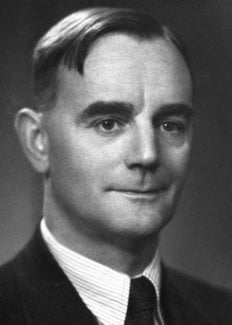Cecil Powell
Biographical

Cecil Frank Powell was born on December 5th, 1903, at Tonbridge, Kent, where his father, Frank Powell, was one of a family of gunsmiths who had long practised the trade in the town. His grandfather, George Bisacre, had established a private school in the nearby town of Southborough and his family ties and influences therefore tended to encourage a regard for the value both of learning and the practical arts.
He attended a local elementary school and won a scholarship, at the age of eleven, to Judd School, Tonbridge. From there he won open scholarships to Sidney Sussex College, Cambridge, where he graduated with First Class Honours in the Natural Science Tripos (1924-1925).
As a postgraduate student, Powell worked in the Cavendish Laboratory under C.T.R. Wilson and Lord Rutherford until 1927 when he gained his Ph.D. and moved to the University of Bristol as Research Assistant to A.M. Tyndall in the H.H. Wills Physical Laboratory. He was eventually appointed lecturer, then reader and, in 1936, he visited the West Indies as seismologist of an expedition investigating volcanic activity. He returned to Bristol in the following year and in 1948 he was established as Melville Wills Professor of Physics.
Powell was Director of a European expedition for making high-altitude balloon flights in Sardinia (1952) and in the Po Valley (1954, 1955, and 1957).
His first researches at the Cavendish Laboratory concerned condensation phenomena and it led indirectly to an explanation of the anomalously high rate of discharge of steam through nozzles. He showed this to be due to the existence of supersaturation in the rapidly expanding steam and his results were found to have a bearing on the design and performance of the steam turbine.
At Bristol he devoted years of patient work to the development of accurate techniques for measuring the mobility of positive ions and to establishing the nature of the ions in most of the common gases. After his sojourn in the Caribbean, he returned to work on the construction of a Cockcroft generator for accelerating fast protons and deuterons – employing them in conjunction with a Wilson chamber, to study neutron-proton scattering. In 1938, he undertook experiments in cosmic radiation and employed methods of directly recording the tracks of the particles in photographic emulsions and, when the Cockcroft machine came into operation, he employed similar methods for determining the energy of neutrons, that is, by observing the tracks of the recoiling protons. The length of the track of a charged particle in the emulsion was found to give an accurate measure of its range and the great advantages of this method for experiments in nuclear physics were soon clearly established.
This development led him to a study of the scattering and disintegration processes produced by a beam of high-energy deuterons and he later returned, with the development of photographic emulsions of increased sensitivity, to experiments on cosmic radiation: in 1947 heavy mesons were discovered and many of their more important properties established.
Powell has contributed numerous papers to learned societies on the discharge of electricity in gases, and on the development of photographic methods in nuclear physics. He is a co-author of Nuclear Physics in Photographs (1947) and The Study of Elementary Particles by the Photographic Method (1959).
Prof. Powell was elected Fellow of the Royal Society in 1949: he was awarded the Hughes Medal in the same year and the Royal Medal in 1961. He has received honorary Doctor of Science degrees from the Universities of Dublin, Bordeaux and Warsaw, and he is a Foreign Member of the Academy of Sciences of the U.S.S.R. He was Vernon Boys Prizeman and Honorary Fellow of the Physical Society (1947), and he served on the Scientific Policy Committee of the European Organization for Nuclear Research (Geneva, 1961).
Powell married Isobel Therese Artner, who has assisted him in his researches, in 1932; they have two daughters. His chief recreations are squash racquets and tennis.
This autobiography/biography was written at the time of the award and first published in the book series Les Prix Nobel. It was later edited and republished in Nobel Lectures. To cite this document, always state the source as shown above.
Cecil Powell died on August 9, 1969.
Nobel Prizes and laureates
Six prizes were awarded for achievements that have conferred the greatest benefit to humankind. The 14 laureates' work and discoveries range from quantum tunnelling to promoting democratic rights.
See them all presented here.
